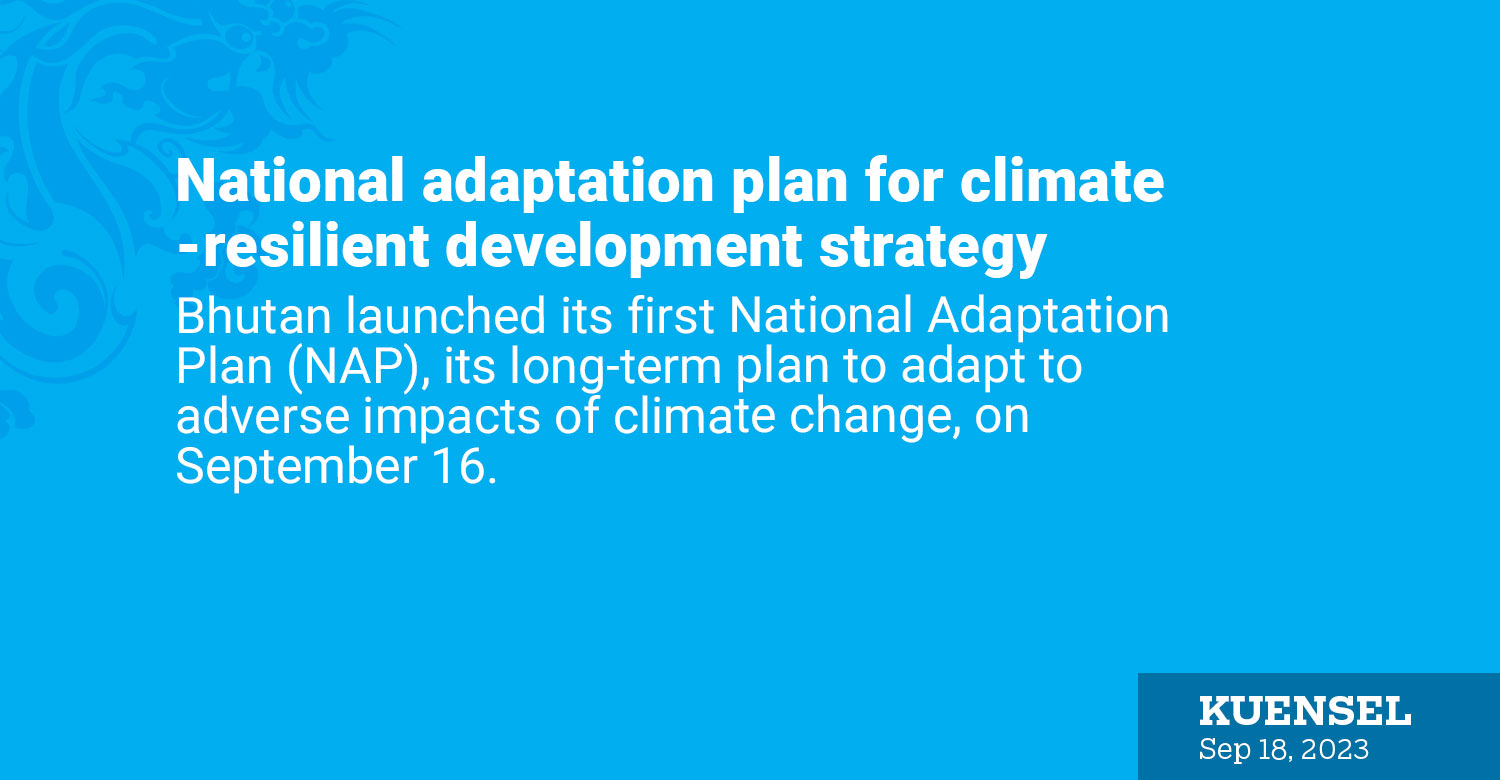YK Poudel
Bhutan launched its first National Adaptation Plan (NAP), its long-term plan to adapt to adverse impacts of climate change, on September 16.
Based on the general obligation for protection of ozone layer, The Vienna Convention for the Protection of the Ozone Layer calls for nations to adopt appropriate legislative or administrative measures and cooperate in harmonizing appropriate policies to control, limit, reduce or prevent human activities under their jurisdiction from having adverse effects resulting from modification or likely modification of the ozone layer.
Now, Bhutan is among the 17 Least Developed Countries in the world that has climate adaptation plan—produced after five years of planning, research, and monitoring the change.
The NAP is a guideline which will guide the relevant departments, sectors and policymakers involved in identifying national priorities that are crucial for adaptation and guide the implementation process.
The initiative began in 2011 under the Cancun Adaptation Framework—this was strengthened during the Paris Agreement in 2015.
The NAP is expected to reduce vulnerability to the impacts of climate change, by building adaptive capacity and resilience and to facilitate the integration of climate change adaptation, in a coherent manner, into relevant new and existing policies, programmes and activities.
Bhutan launched the NAP process in May 2015 after a “Dialogue on Climate Resilient and Carbon Neutral Development.”
The project worth USD 2.9 million, started in 2019 with support from Green Climate Fund and the United Nations Development Programme—focusing on sectors like water, agriculture and livestock, forest and biodiversity, human settlement and climate smart cities, health, energy, climate service and disaster risk reduction.
Long-Term Low Greenhouse Gas Emission and Climate Resilient Development Strategy (LTS) shows that terrible loss and damage caused by climate-related disasters in LDCs—about 69 percent of worldwide deaths are caused by climate-related disasters in LDCs. In 2019, the LDCs set out a 2050 vision to deliver climate-resilient development pathways by 2030 and net-zero emissions by 2050 to ensure our societies and ecosystems thrive.
According to “Assessment for Climate Risks on Agriculture for NAP formulation,” over the past years, the country has been exposed to a range of hazards, including cyclone-induced storms, floods, earthquakes, GLOF, and drought.
In 1957, 1960, 1968, and 1994, several GLOFs were experienced in the country—the main causes of flooding and landslides are heavy seasonal mountain rains and glacial melting in Bhutan.
The climate change risk assessment on forest and biodiversity 2021 and National Forest Inventory 2023 points out that forest coverage has been on steep decline over the years—the fire is one of the causes with 19 reported cases in 2022. Over 7,000 hectares of forest area are burnt annually, emitting 84.48 gigatons of CO2. The timber felling and grazing are among the highest contributors to forest health disturbance.
Similarly, the GNH survey of 2022 found that 67 percent of farmers say there is either too much rain or too little rain for farming depending on location. This means the rainfall has not really helped the farmers economically. Forecast from hydrology and meteorology projects a rise of 1.5ºC global temperature.
Agricultural production and livestock mortality are another pertinent issue. Agricultural production and livestock were both seen decreasing over the years. The animal health centre data show 2,187 bovine deaths in the past eight months this year—a total of 21,472 bovine and 232,758 other livestock fatalities reported last year.
The NAP aims to create awareness among the public and relevant people to ensure that the people are aware and step forth in the adaptation and mitigation of issues associated with climate change.
The strategy was developed by the Department of Environment and Climate Change with support from the European Climate Foundation.
Observing World Ozone Day, the Long-Term Low Greenhouse Gas Emission and Climate Resilient Development Strategy were also launched on the day.


